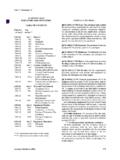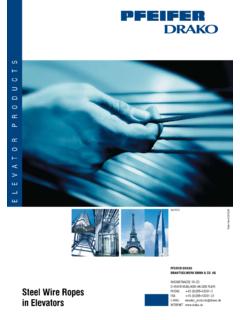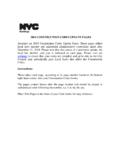Transcription of ELEVATOR MACHINE ROOM EQUIPMENT …
1 ELEVATOR MACHINE room EQUIPMENT guarding A BEST PRACTICES GUIDELINE PRODUCED BY INDUSTRY STAKEHOLDERS May 21, 2009 ELEVATOR MACHINE room EQUIPMENT guarding Guideline ELEVATOR MACHINE room EQUIPMENT guarding Guideline TABLE OF CONTENTS GUIDELINE COMMITEE ..1 Part INTRODUCTION ..3 Part EXECUTIVE SUMMARY ..6 Part Part PURPOSE ..8 Part REVIEW OF REGULATORY SUMMARY OF REGULATORY REQUIREMENTS ..10 CRITICAL ELEMENTS OF ONTARIO REGULATION 851 ..10 OTHER CRITICAL REQUIREMENTS IN ONTARIO REGULATION 851 ..11 RELEVANT REQUIREMENTS FROM ONTARIO REGULATION 209/01 (ELEVATING DEVICES) ..11 ADDITIONAL REQUIREMENTS AS SET OUT IN THE B44 SAFETY CODE FOR REQUIREMENTS FROM THE ONTARIO ELECTRICAL SAFETY CODE.
2 14 Part MOL BACKGROUND INFORMATION ..16 Part EXPLANATION OF HAZARDS AND HAZARD RANKING ..18 COMMON HAZARDS ..18 TABLE A HAZARD IDENTIFICATION CHART & PHOTO REFERENCE REFERENCE PHOTOGRAPHS AND ADDITIONAL MATERIAL ..20 Part EQUIPMENT guarding & SPECIFIC ITEMS OF ESSENTIAL DESIGN ELEMENTS ..21 ADDITIONAL guarding CONCERNS ..22 SUGGESTED guarding SYSTEMS AND METHODOLOGY ..23 MACHINE Drive Motor ..28 Encoder ..29 ELEVATOR MACHINE room EQUIPMENT guarding Guideline Motor Generator Selector ..29 Car Controller Cabinets ..30 Dispatcher Or Common Relay Panel Controllers ..30 Car Counterweight Governor ..31 Rope Gripper ..31 Deflector Sheaves ..31 Hydraulic Elevators ..31 APPENDIX SECTION APPENDIX SECTION guarding PHILOSOPHY & REQUIREMENTS.
3 44 Safeguarding of Machinery ..44 Essential guarding Design Issues ..44 TABLE 3 Minimum Distance From Hazard As A Function Of Barrier Opening APPENDIX SECTION REFERENCE PHOTOGRAPHS ..46 Cover photograph is courtesy of Telford D. John & Associates. This photo shows but one example of ELEVATOR EQUIPMENT guarding . It is not the soul option and therefore not reflective of other options available. ELEVATOR MACHINE room EQUIPMENT guarding Guideline 1 GUIDELINE COMMITEE In response to concerns raised by Building Owners and the ELEVATOR Industry, the Technical Standards and Safety Authority (TSSA) in conjunction with its Elevating Devices Advisory Council recommended the formation of a task group drawn from industry stake holders.
4 Its purpose was to review the issue of ELEVATOR MACHINE room EQUIPMENT guarding and assist in the development of an industry produced guideline or reference document highlighting current best practices concerning EQUIPMENT guarding . The guideline could then be used by building owners and the ELEVATOR industry to better understand the requirements of ELEVATOR MACHINE room EQUIPMENT guarding , and assist in the development of appropriate design requirements for such provisions when applied to ELEVATOR installations. The Committee first met in the spring of 2007 and the results of their efforts is this guideline. Committee participants were; Mr. Clifford Ayling (chair), Ayling Consulting Services Inc.
5 & Brookfield Properties Ltd. Mr. Donald Brown, Ministry of Labour Mr. Wayne De L Orme, Ministry of Labour Mr. John Egan (secretary), Fujitec Canada, Inc. Mr. Roger Girling (secretary), Canadian ELEVATOR Contractors Association (CECA) Mr. Cy Gray, TSSA Ms. Karen Hanna, Ministry of Labour Mr. Telford John, Telford D. John & Associates Mr. Rob Kremer, TSSA Mr. Robert Last, Arcturus Realty Corporation Mr. Bob Miller, Otis Canada, Inc. Mr. Troy Pelletier, Minto Properties & FRPO Mr. Peter Russel, H. H. Angus & Associates Mr. Rick Sokoloff, Independent ELEVATOR Contractors Association (IECA) Mr. Ron Takamaki, Takamaki Consultants Inc. In addition, the following groups participated to some degree during the process of preparing this Guideline.
6 Elevating Devices Advisory Council (EDAC), working in combination with the TSSA. Field Advisory Committee (FAC), working in combination with the TSSA. The work of this Guideline Committee and the purpose of this Guideline were not to replace or amend regulatory requirements relating to EQUIPMENT guarding . The purpose of the Guideline is to assist employers, supervisors and workers on recognizing hazards and determining the ways that they may best comply with their obligations under the Occupational Health and Safety Act (OHSA), and the relevant regulations made under the OHSA. This Guideline also provides the workplace parties with information to consider in determining how to prevent injuries and protect worker health and safety while maintaining public safety.
7 The Guideline should not be taken as a statement of law or what is necessary to comply with the law, nor does it relieve the workplace parties from their obligations to comply with the provisions of the OHSA and its associated regulations. 2 ELEVATOR MACHINE room EQUIPMENT guarding Guideline Ministry of Labour (MOL) inspectors will assess the workplace situations against the relevant provisions in the OHSA and its regulations. Although the Guideline will be made available to both MOL and TSSA inspectors, the Guideline will not be enforced by MOL and TSSA inspectors. Rather, it will be used as a resource document while conducting their respective regulatory mandates.
8 These inspectors will continue to apply and enforce the specific requirements of their respective codes and regulations. Comments about the Guideline can be forwarded to the Field Advisory Committee (FAC) via email. The email address is Please note that the FAC meets three times per year. Inquires and questions will be included as part of their ongoing meeting agendas, and responses will follow thereafter. The date of this guideline is May 21st, 2009. ELEVATOR MACHINE room EQUIPMENT guarding Guideline 3 Part 1 INTRODUCTION The implementation of guarding EQUIPMENT within ELEVATOR MACHINE room spaces is part of the mandate of the Ministry of Labour (MOL) to protect the health and safety of workers and to reduce workplace injuries.
9 No amount of training, certification, licensing or experience will likely prevent 100% workplace injuries. The potential for inadvertent injury within an unprotected environment is high, notwithstanding current accident and injury statistics within these locations. Reliance upon a locked MACHINE room access door, with limited available access does not constitute sufficient or appropriate guarding , even when used with lock out/tag out procedures and the safe shutdown of live EQUIPMENT whenever the ELEVATOR MACHINE room access door is opened. Once through the door, where live unguarded EQUIPMENT remains in operation, a worker is still exposed to potential hazards within the MACHINE room .
10 The requirements for ELEVATOR MACHINE room EQUIPMENT guarding comes from Sections 24, 25, 75 and 76 of the Regulations for Industrial Establishments, Ontario Regulation 851 (O. Reg. 851) made under the OHSA. The OHSA and its regulations are enforced by the MOL. MOL has had an increased enforcement present in Ontario workplaces since 2004 with the hiring of 200 additional occupational health and safety inspectors. Since 2004, MOL has been proactively visiting firms that may not have been previously inspected ( , retail, offices and related services, tourism, hospitality and recreation services). Many of these firms have elevating devices on the premises, which are included as part of the workplace, and therefore can be inspected by an MOL inspector.



